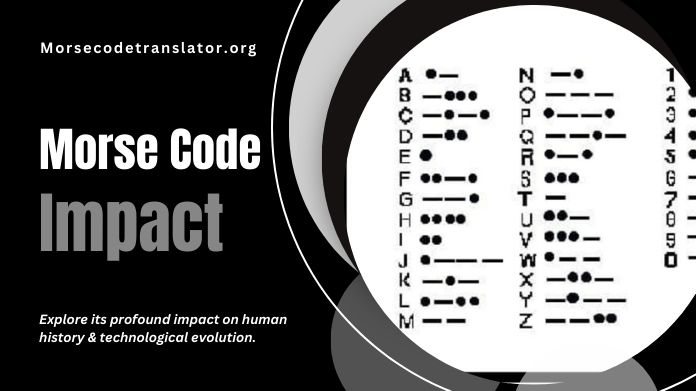Morse code, a revolutionary communication system comprising dots and dashes, has wielded significant influence throughout human history since its inception in the early 19th century.
This encoding method, which Samuel Morse and Alfred Vail developed, transformed long-distance communication by enabling messages to traverse vast distances via telegraph lines.
Its simple yet ingenious encoding scheme, utilizing combinations of short and long signals, facilitated the rapid transmission of information previously deemed impossible.
The Morse code impact resonates across multiple domains, from its pivotal role in telegraphy to its profound influence on military operations, exploration, and cultural expression.
Its adoption spurred global connectivity, fostering trade, diplomacy, and the exchange of ideas on an unprecedented scale. Moreover, Morse code has captivated imaginations, permeating popular culture and symbolizing themes of communication, resilience, and human ingenuity.
We learn about the complex history of Morse code impact, its lasting influence in the digital age, and its many effects on human society. Come along on a historical voyage as we examine the development of Morse code and its significant impact on the development of human history.
From its modest origins to its ongoing significance in the contemporary world, Morse code is evidence of the transforming ability of communication to break down boundaries and bring people together.
What is Morse Code?
Morse code is a communication system representing letters, numbers, and punctuation with dots and dashes. Samuel Morse and Alfred Vail created Morse code in the early 1800s, and it was first applied to telegraph systems to send communications across great distances using electrical impulses. Dots (short signals) and dashes (long signals) uniquely represent each letter of the alphabet, numbers, and punctuation.
For example, the letter “A” is represented by “.-“, “B” by “-…”, “C” by “-.-.”, and so on. Longer pauses represent spaces between letters and words. Morse code can be transmitted using sound, light, or other methods, with operators trained to interpret the sequences of dots and dashes.
Despite advancements in communication technology, Morse code remains relevant today, particularly in emergencies and amateur radio communication, and as a means of encoding messages for transmission in challenging environments. Its simplicity and resilience have contributed to its enduring legacy as a versatile and effective method of communication.
Morse Code Impact on Human History

Morse code has profoundly impacted human history, significantly shaping communication, technology, and society since its invention in the early 19th century.
Here are some key aspects of Morse code impact on human history:
1. Revolutionized Communication
Morse code revolutionized long-distance communication by enabling messages to be transmitted rapidly across vast distances via telegraph lines.
This facilitated near-instantaneous communication between distant locations, transforming the way information was exchanged and enabling global connectivity on an unprecedented scale.
2. Facilitated Global Connectivity
The adoption of Morse code facilitated global connectivity, fostering trade, diplomacy, and the exchange of ideas across continents and oceans.
Telegraph lines were laid worldwide, linking distant cities and enabling real-time communication. This interconnectedness was crucial in shaping modern geopolitics, economics, and culture.
3. Military Applications
Morse code played a pivotal role in military operations, serving as a secure and reliable means of communication on the battlefield.
During the conflict, military forces used Morse code extensively to transmit orders, coordinate troop movements, and relay vital intelligence. Its simplicity and resilience made it indispensable when other forms of communication were unreliable or compromised.
4. Exploration and Innovation
Morse code accompanied explorers and adventurers on their expeditions to the far reaches of the globe. From the Arctic to the Antarctic, Morse code facilitated communication between explorers, scientists, and support teams, enabling them to share discoveries, coordinate logistics, and call for assistance in times of need.
Additionally, Morse code laid the foundation for future developments in telecommunications, inspiring the invention of new communication technologies and encoding systems.
5. Cultural Impact
Beyond its practical applications, Morse code has left an enduring legacy in popular culture, inspiring fascination and intrigue among people worldwide.
Its distinctive rhythm and cadence have been immortalized in literature, music, and film, symbolizing themes of communication, connection, and human ingenuity.
Overall, Morse code impact on human history is far-reaching and multifaceted, leaving an indelible mark on communication, technology, and society that continues to resonate in the modern world. Its legacy as a versatile and effective method of communication endures, serving as a testament to the power of innovation and human ingenuity to shape the course of history.
Conclusion
Morse code has left an indelible mark on human history by revolutionizing communication, fostering global connectivity, and playing a vital role in military operations and exploration.
Its simple yet effective encoding system enabled rapid transmission of messages across vast distances, transforming how information was exchanged and societies were connected. Morse code’s resilience and versatility made it invaluable in various contexts, from emergencies to diplomatic communications.
Its enduring legacy continues to shape modern telecommunications and is a testament to human ingenuity and innovation in overcoming communication barriers.
As we reflect on its impact, Morse code stands as a symbol of the power of technology to transcend boundaries and unite people across the globe.
